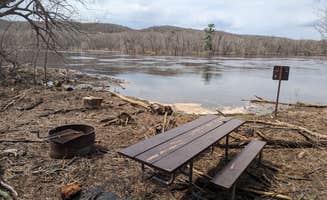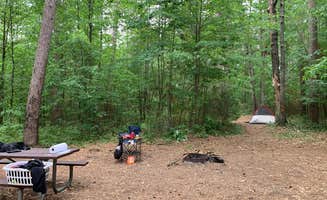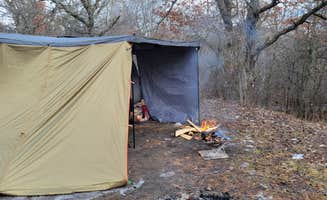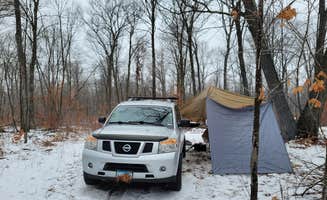Primitive camping near Lent, Minnesota offers seclusion in the mixed hardwood forests and sandy terrain characteristic of east-central Minnesota. Most dispersed sites sit on higher sandy soils that drain quickly after rain, making them accessible even after wet weather. Winter temperatures regularly drop below 0°F, while summer humidity creates dense mosquito populations from June through August.
What to do
Riverside hiking: Sandy Cove on the St. Croix River offers access to the Ice Age Trail with both improved and natural paths. "The crushed gravel path to the south makes travel to the nearby Lions park easy," notes Travis B., who adds that the site includes "a pad at the bottom of the path up to the open air vault toilet, a fire ring, and a table."
Wildlife watching: Watch for varied species across the region's forests and wetlands. At Rum River State Forest Dispersed, Art S. reports: "We did encounter a lot of birds as well as deer." Winter campers might experience more unusual encounters, as Johnny H. describes: "I did hear wolves for the first time. They were howling after sunset. A little creepy, camping alone."
Paddling access: Many riverside sites allow direct water access for canoes and kayaks. Some campers arrive by water at sites like Sandrock Cliffs, where one visitor observed "a large group of kids that arrived by canoe/kayak" taking advantage of the river access.
What campers like
Seclusion and privacy: Many sites offer significant separation from other campers. At South of Sand Dunes State Forest, Alison O. recommends to "drive until a decay path opens, park, then trek 100–300 ft off-road to your camp." Skip H. found a prime spot at Rum River: "It was through a ditch and up a small hill and set back in the woods. I spent 3 days here with only one car passing through on the first night."
Cell coverage in remote areas: Surprisingly good connectivity exists at certain sites. Erin G. reports from Rum River State Forest: "The cell service with Verizon is good enough to stream videos and work on your laptop with ease." This contrasts with Sand Dunes, where campers note "unreliable cell coverage, even for Verizon."
Quick access from urban areas: Many sites offer wilderness experiences within short drives from the Twin Cities. One camper calls Rum River State Forest "rugged wilderness along a gravel road with plenty of space to park," while others appreciate these forests for "secluded, minimal camping... close to the twin cities."
What you should know
Bug protection is essential: Ticks and mosquitoes are abundant, particularly in summer. At South of Sand Dunes State Forest, Samuel C. advises to "bug up at first signs of dusk—mosquitoes and ticks love these woods." Art S. mentions finding ticks quickly at Rum River, prompting them to stick to road hiking rather than bushwhacking.
Site maintenance varies widely: Some areas show signs of heavy use or misuse. At Sandrock Cliffs, Joslyn H. found "most of the sites were full of trash and broken tent poles" and observed that "it seems to be a place that gets abused by the locals as a party area."
Road conditions require planning: Winter access particularly demands appropriate vehicles. Johnny H. cautions that at Rum River: "The roads aren't really kept up for the winter. So, you'll want 4 wheel drive and slow and mindful driving."
Tips for camping with families
Easier sites for kids: Choose locations with basic facilities when camping with children. Emily found Sandrock Cliffs suitable, noting "Each one has a fire pit and a picnic table, and you could probably fit three or more tents at each site."
Off-season visits reduce party crowds: For quieter experiences with children, avoid summer weekends at road-accessible sites. Joslyn H. suggests: "Since this spot is accessible by road I'm assuming that its best not to visit in the summer... I may consider visiting again in the fall when it is hopefully less busy."
Wildlife education opportunities: The abundant animal sightings create natural learning experiences. County Road O Landing offers riverside habitats where one camper "woke up to amazing bird calls," providing opportunities to identify local species with children.
Tips from RVers
Size-appropriate sites: Large rigs can fit at select locations. Ronney P. reports from Rum River State Forest Dispersed: "pull off sites big have a 37 ft fifth wheel no problem nice an quiet." Rick M. confirms the forest offers "plenty of space to park" for larger vehicles.
Pull-through options: Some areas offer easier access for trailers. Skip H. notes about South of Sand Dunes State Forest: "Best for straight vehicles or very small trailers," while Heather W. mentions finding "One pull through area" in the same forest.
Road traffic awareness: Consider site placement relative to forest roads. Ryan P. warns at South of Sand Dunes: "This road is pretty busy for a dirt forest road and people FLY down it. Almost got hit a few times walking. Even through a Wednesday night cars are flying down the road."





